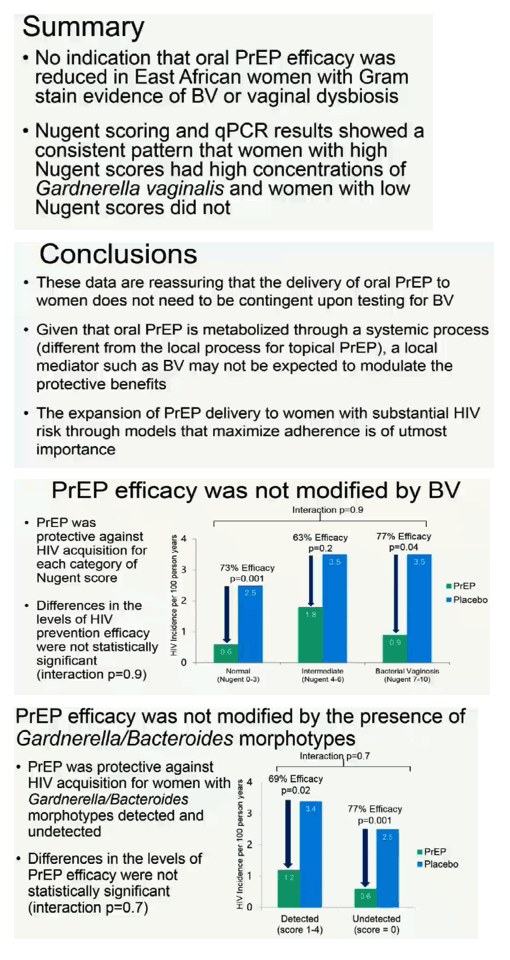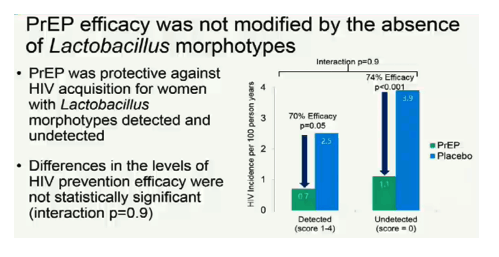 |
 |
 |
| |
Bacterial Vaginosis Does Not Affect Oral TDF/FTC PrEP Efficacy
|
| |
| |
Conference on Retroviruses and Opportunistic Infections (CROI), February 13-16, 2017, Seattle
Mark Mascolini
Gram-stain evidence of bacterial vaginosis or vaginal dysbiosis did not affect efficacy of daily oral tenofovir/emtricitabine (TDF/FTC) preexposure prophylaxis (PrEP) in African women enrolled in the Partners PrEP trial [1]. The researchers believe their findings "are reassuring that delivery of oral PrEP to women does not need to be contingent upon testing for bacterial vaginosis."

The Partners PrEP study in Kenya and Uganda established the efficacy of oral TDF/FTC or TDF PrEP in heterosexual women and men [2]. Oral PrEP did not protect women from HIV in trials in which women adhered poorly to daily pill taking, and these results sparked speculation that biologic mechanisms may thwart PrEP efficacy in women. Vaginal dysbiosis marked by high levels of Gardnerella vaginalis in genital microbiota is common in African women. In the South African CAPRISA 004 trial, 1% tenofovir gel did not block HIV in women with vaginal dysbiosis. Some hypothesized that G vaginalis degrades tenofovir.
To address these issues, Partners PrEP researchers examined data from their trial. Partners PrEP enrolled 1785 HIV-negative women in Kenya and Uganda and randomized them to daily TDF or TDF/FTC PrEP or to placebo through 36 months of follow-up. Women had monthly testing for HIV infection and pregnancy plus individualized adherence counseling.
The investigators checked yearly for bacterial vaginosis by examining slides prepared from vaginal swabs. They used Gram stain to determine a Nugent score. A Nugent score of 0-3 is normal, 4-6 intermediate, and 7-10 bacterial vaginosis. The Nugent score algorithm provides individual scores for Lactobacillus morphotypes, Gardnerella/Bacteroides morphotypes, and curved gram-variable rods. The researchers had quantitative PCR data from 107 study visits by women in the placebo arm who did not become infected with HIV.
The primary aim of this analysis was to compare HIV incidence (the new-infection rate) in women randomized to PrEP versus placebo with or without bacterial vaginosis (Nugent score 7-10 versus 0-3). For this analysis, the researchers used Cox proportional hazards regression with time-varying bacterial vaginosis status in an interaction term with the randomized arm. The analysis included 1470 women with a median age of 33 years, 67% of them randomized to PrEP with TDF or TDF/FTC. At the baseline visit, 64% of women had a Nugent score 0-3, 12% had a score of 4-6, and 24% had a score of 7-10 (indicating bacterial vaginosis).
Among women with bacterial vaginosis, HIV incidence was 0.9 per 100 person-years in the PrEP arm and 3.5 per 100 person-years in the placebo arm, results indicating 77% PrEP efficacy (P = 0.04). PrEP also protected women with a Nugent score of 0-3 (HIV incidence 0.6 versus 2.5 per 100 person-years, 73% efficacy, P = 0.001) and women with a score of 4-6 (HIV incidence 1.8 versus 3.5, 63% efficacy, not significant at P = 0.2). Differences in efficacy across the three Nugent score groups were not statistically significant (P = 0.9).
PrEP protected women regardless of whether they had detectable Gardnerella/Bacteroides morphotypes (63% efficacy with detected morphotypes, P = 0.02; 77% efficacy without detected morphotypes, P = 0.001). And detection of Lactobacillus morphotypes did not affect PrEP efficacy (70% efficacy with detected morphotypes, P = 0.05; 74% efficacy without detected morphotypes, P < 0.001).
Results proved similar when based on Nugent score at study enrollment rather than time-varying Nugent score. Statistical adjustment for use of the antibiotic metronidazole did not change PrEP efficacy results. Additional analyses confirmed high correlations between Nugent score and G vaginalis and L crispatus concentrations.
The Partners PrEP team concludes there is "no indication that oral PrEP efficacy was reduced in East African women with Gram stain evidence of bacterial vaginosis or vaginal dysbiosis." Because oral PrEP is metabolized systemically (rather than locally as with topical PrEP), the researchers propose that "a local mediator such as bacterial vaginosis may not be expected to moderate the protective benefits."
WEBCAST: http://www.croiwebcasts.org/console/player/33458?mediaType=slideVideo&


References
1. Heffron R, McClelland RS, Balkus J, et al. Daily oral prep is effective among women with abnormal vaginal microbiota. Conference on Retroviruses and Opportunistic Infections (CROI), February 13-16, 2017, Seattle. Abstract 85.
2. Baeten JM, Donnell D, Ndase P, et al. Antiretroviral prophylaxis for HIV prevention in heterosexual men and women. N Engl J Med. 2012;367:399-410. http://www.nejm.org/doi/full/10.1056/NEJMoa1108524
|
| |
|
 |
 |
|
|